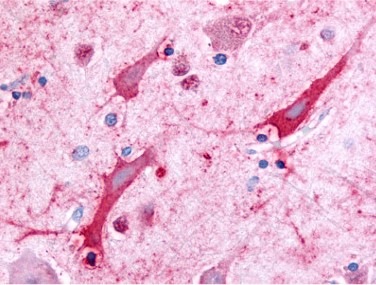Anti-Ceramide Kinase Antibody (13805)
$454.00
SKU: 13805
Categories: Antibody Products, Enzymes and Enzyme Inhibitor Antibodies, Products
Overview
Product Name Anti-Ceramide Kinase Antibody (13805)
Description Anti-Ceramide Kinase Rabbit Polyclonal Antibody
Target Ceramide Kinase
Species Reactivity Human
Applications IHC,IHC-P
Host Rabbit
Clonality Polyclonal
Immunogen Synthetic peptide conjugated to KLH.
Properties
Form Liquid
Concentration Lot Specific
Formulation PBS containing 0.1% sodium azide
Buffer Formulation Phosphate Buffered Saline
Buffer Anti-Microbial 0.1% Sodium Azide
Format Purified
Purification Purified by peptide immuno-affinity chromatography
Specificity Information
Specificity This antibody recognizes the N-terminal extracellular domain of human CERK.
Target Name Ceramide kinase
Target ID Ceramide Kinase
Uniprot ID Q8TCT0
Alternative Names hCERK, EC 2.7.1.138, Acylsphingosine kinase, Lipid kinase 4, LK4
Gene Name CERK
Accession Number NP_073603.2
Sequence Location Cytoplasm, Cell membrane, Peripheral membrane protein
Biological Function Catalyzes specifically the phosphorylation of ceramide to form ceramide 1-phosphate (PubMed:11956206, PubMed:16269826, PubMed:19168031). Acts efficiently on natural and analog ceramides (C6, C8, C16 ceramides, and C8-dihydroceramide), to a lesser extent on C2-ceramide and C6-dihydroceramide, but not on other lipids, such as various sphingosines (PubMed:11956206, PubMed:16269826, PubMed:19168031). Shows a greater preference for D-erythro isomer of ceramides (PubMed:16269826). Binds phosphoinositides (PubMed:19168031). {PubMed:11956206, PubMed:16269826, PubMed:19168031}.
Research Areas Enzymes
Background Ceramide kinase (CERK), which phosphorylates ceramide to produce ceramide 1-phosphate (C1P), was first described as a Ca+2-stimulated lipid kinase that copurified with brain synaptic vesicles. CERK activity has been reported in HL60 cells, mast cells, and neutrophils. CERK is involved in phagolysosome formation in plymorphonuclear leukocytes and also in liposome fusion. C1P has been reported to have mitogenic effects. More recently, C1P was found to induce arachidonic acid release and prostanoid synthesis.
Application Images


Description Immunohistochemistry: Use at 20ug/ml. Brain cortex: Formalin-fixed, paraffin-embedded.
Handling
Storage This antibody is stable at 4°C (short- term) and -70°C (long-term).
Dilution Instructions Dilute in PBS or medium that is identical to that used in the assay system.
Application Instructions
Immunohistochemistry: Use at 20ug/ml.
Immunohistochemistry: Use at 20ug/ml.
References & Data Sheet
Data Sheet  Download PDF Data Sheet
Download PDF Data Sheet
 Download PDF Data Sheet
Download PDF Data Sheet


